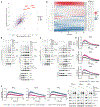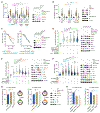CDK-independent role of D-type cyclins in regulating DNA mismatch repair
- PMID: 38458201
- PMCID: PMC10997477
- DOI: 10.1016/j.molcel.2024.02.010
CDK-independent role of D-type cyclins in regulating DNA mismatch repair
Abstract
Although mismatch repair (MMR) is essential for correcting DNA replication errors, it can also recognize other lesions, such as oxidized bases. In G0 and G1, MMR is kept in check through unknown mechanisms as it is error-prone during these cell cycle phases. We show that in mammalian cells, D-type cyclins are recruited to sites of oxidative DNA damage in a PCNA- and p21-dependent manner. D-type cyclins inhibit the proteasomal degradation of p21, which competes with MMR proteins for binding to PCNA, thereby inhibiting MMR. The ability of D-type cyclins to limit MMR is CDK4- and CDK6-independent and is conserved in G0 and G1. At the G1/S transition, the timely, cullin-RING ubiquitin ligase (CRL)-dependent degradation of D-type cyclins and p21 enables MMR activity to efficiently repair DNA replication errors. Persistent expression of D-type cyclins during S-phase inhibits the binding of MMR proteins to PCNA, increases the mutational burden, and promotes microsatellite instability.
Keywords: AMBRA1; CDK4; D-type cyclins; DNA repair; DNA repair pathway choice; G0 DNA repair; G1 DNA repair; PCNA; base excision repair; cell cycle; cullin-RING ubiquitin ligases; cyclin D1; genome stability; mismatch repair; oxidative DNA damage.
Copyright © 2024 The Author(s). Published by Elsevier Inc. All rights reserved.
Conflict of interest statement
Declaration of interests P.S. has been a consultant at Novartis, Genovis, Guidepoint, The Planning Shop, ORIC Pharmaceuticals, Cedilla Therapeutics, Syros Pharmaceuticals, Blueprint Medicines, Curie Bio, Differentiated Therapeutics, Excientia, Blueprint, Ligature Therapeutics, Merck, Redesign Science, Sibylla Biotech, and Exo Therapeutics; his laboratory receives research funding from Novartis. M.P. is or has been an advisor for and has financial interests in SEED Therapeutics, Triana Biomedicines and CullGen, Kymera Therapeutics, and Umbra Therapeutics.
Figures







Update of
-
D-type cyclins regulate DNA mismatch repair in the G1 and S phases of the cell cycle, maintaining genome stability.bioRxiv [Preprint]. 2024 Jan 13:2024.01.12.575420. doi: 10.1101/2024.01.12.575420. bioRxiv. 2024. Update in: Mol Cell. 2024 Apr 4;84(7):1224-1242.e13. doi: 10.1016/j.molcel.2024.02.010. PMID: 38260436 Free PMC article. Updated. Preprint.
References
-
- Lukas J, Pagano M, Staskova Z, Draetta G, and Bartek J (1994). Cyclin D1 protein oscillates and is essential for cell cycle progression in human tumour cell lines. Oncogene 9, 707–718. - PubMed
MeSH terms
Substances
Grants and funding
LinkOut - more resources
Full Text Sources
Research Materials
Miscellaneous

